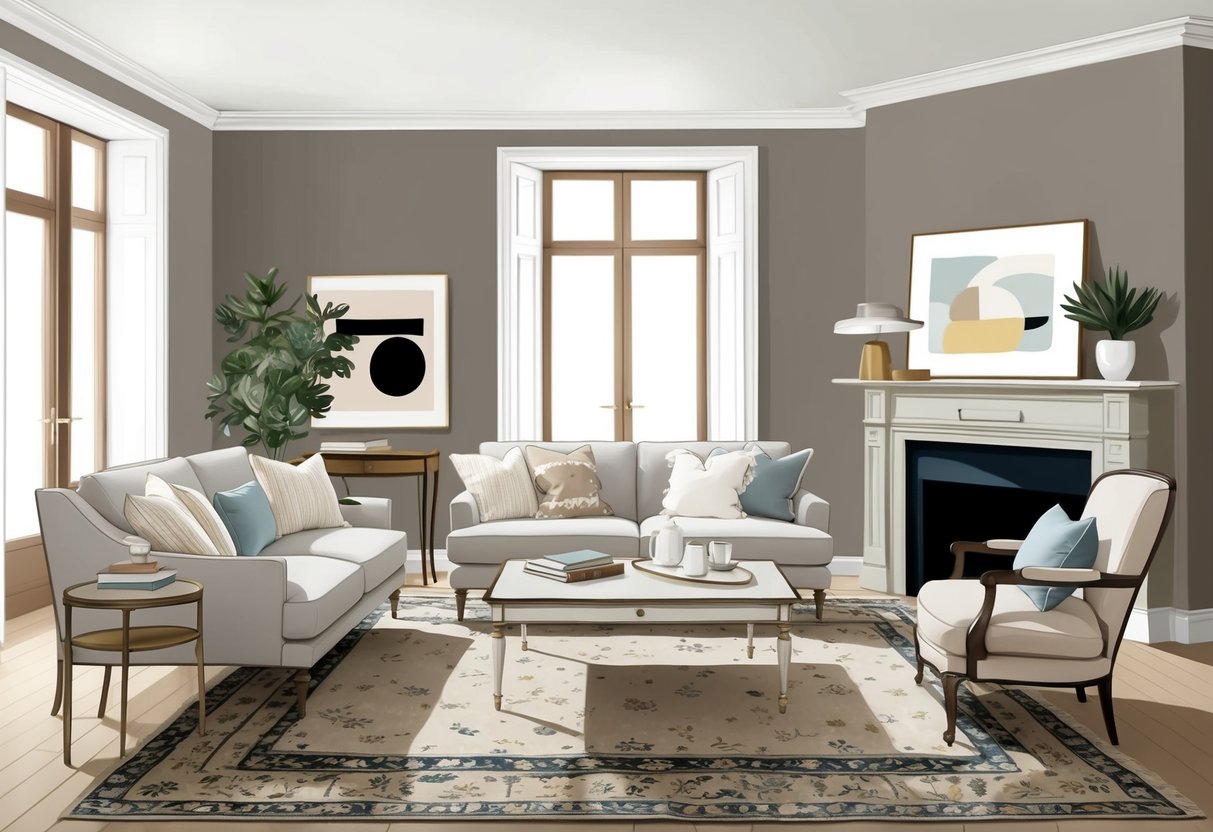
Balancing Modern and Traditional Elements
Achieving a harmonious blend of modern and traditional decor relies on smart layering and thoughtful mixing of different styles, materials, and accessories.
Success depends on balancing these elements so that neither overpowers the other, creating a timeless and comfortable home environment.
Layering Furniture and Accessories
Layering brings depth to any space by placing traditional and modern elements side by side.
Classic furniture pieces, such as a tufted sofa or an ornate wooden table, can be combined with modern accessories like metallic lamps or minimalist glass coffee tables.
This mix and match approach highlights the unique qualities of both styles while making the room feel curated.
Color plays a key role when layering.
Using neutral hues or a consistent color palette helps unify traditional and modern elements without visual clutter.
Grouping accessories in varying heights and shapes is effective, such as arranging both antique vases and sleek ceramics on a mantel.
Texture is another important factor.
Layering plush rugs, smooth concrete, polished woods, and soft textiles helps tie the look together.
Adding modern lighting above traditional seating or a contemporary mirror above a fireplace mantel enhances the dynamic contrast between styles.
For more on creating harmony with decor, visit this guide on balancing modern and traditional design.
Incorporating Vintage Finds with Modern Touches
Blending vintage finds into a modern home requires an eye for balance and function.
Start by selecting vintage pieces with character, like a carved dresser or a retro accent chair.
Pair these with modern touches such as streamlined shelving, geometric pendants, or bold abstract art for visual interest.
To keep vintage elements from overwhelming, limit their number and focus on quality rather than quantity.
A single antique mirror or a set of vintage candlesticks can stand out when surrounded by modern decor.
Mixing styles within the same room—such as a vintage trunk with a modern platform bed—introduces personality and avoids monotony.
When incorporating older items, consider their color and finish.
Repainting, reupholstering, or refinishing vintage finds can help them blend with contemporary surroundings.
Use a mix of old and new in displays or tablescapes, combining items like mid-century lamps with modern books or ceramics.
Explore more advice on how to mix these decor elements in this detailed guide to mixing modern and traditional decor.
Establishing a Cohesive Look
A cohesive look in home decor depends on purposefully blending aesthetics so that modern and traditional pieces feel unified.
By concentrating on harmony, common design threads, and strategic use of form, any home can achieve timeless appeal.
Achieving Harmonious Balance
To create a harmonious balance between modern and traditional styles, start with a unified color palette.
Neutral tones like whites, grays, or earth tones lay a foundation that connects different eras of furnishings.
This approach minimizes visual clutter and helps the eye move smoothly across the room.
Mixing materials, such as pairing a sleek glass coffee table with a classic tufted sofa, adds interest without disrupting cohesion.
Textiles are also vital—layering modern fabrics on traditional shapes ties elements together.
Consider scale, ensuring that traditional and modern pieces have compatible sizes so one does not visually overpower the other.
Strategic repetition is equally important.
Repeating wood finishes, metallic accents, or similar silhouettes reinforces a cohesive look.
As highlighted in many design guides, using these common threads ensures a consistent and inviting environment that feels neither too eclectic nor too rigid.
Explore expert tips for combining design styles for further insights.
Using Symmetry and Asymmetry
Symmetry often plays a role in traditional decor, offering order and visual stability.
For example, using matching table lamps or artwork on either side of a mantel brings a sense of structure.
This technique grounds a space, making it feel organized and intentionally planned.
However, introducing asymmetry adds a modern edge and keeps the room from feeling predictable.
Arranging a variety of artwork sizes in a gallery wall or placing an eye-catching modern light fixture slightly off-center helps break monotony.
Balance remains essential, but with asymmetry, a room stays dynamic and visually engaging.
Combining both approaches ensures the decor does not lean too far into old-fashioned or ultra-contemporary aesthetics.
Embracing symmetry where it feels natural, while allowing for well-considered asymmetry, encourages personality without sacrificing a cohesive flow.
This balance is key for homeowners seeking a space that feels curated and timeless.
For detailed guidance on designing a cohesive home that flows, consult current expert advice.
Creating Focal Points in Your Home
A well-placed focal point anchors a room’s home design and brings together both modern and vintage decor.
Achieving balance relies on how these elements draw attention and add interest to different spaces.
Highlighting Architectural Elements
Architectural elements such as built-in shelving, fireplaces, arched doorways, ceiling beams, or large windows naturally command attention in a space. These features establish the room’s structure and serve as ideal focal points for blending modern and traditional styles.
Enhancement starts with drawing the eye toward these areas using lighting, contrasting paint colors, or bold wall treatments. For instance, accent lighting along a fireplace mantel makes both modern accessories and traditional vintage decor stand out.
Keep the area around the architectural feature minimal so that it remains the main highlight. Incorporate subtle pops of color or texture nearby, but avoid cluttering the focal area with too many competing items.
Highlight a unique doorway or window by framing it with modern drapes or traditional woodwork. This creates visual interest and sets the tone for the entire room.
According to expert advice on balancing styles, integrating complementary decorations enhances these focal points without overwhelming them.